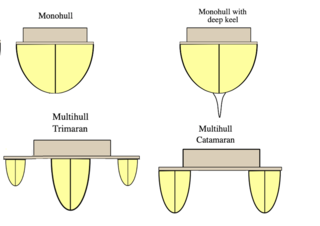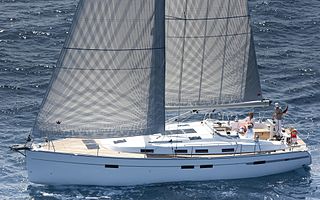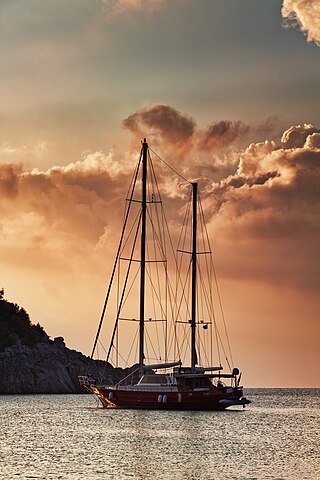
A multihull is a boat or ship with more than one hull, whereas a vessel with a single hull is a monohull. The most common multihulls are catamarans, and trimarans. There are other types, with four or more hulls, but such examples are very rare and tend to be specialised for particular functions.

A yacht is a sailing or power vessel used for pleasure, cruising, or racing. There is no standard definition, though the term generally applies to vessels with a cabin intended for overnight use. To be termed a yacht, as opposed to a boat, such a pleasure vessel is likely to be at least 33 feet (10 m) in length and may have been judged to have good aesthetic qualities.

A sailboat or sailing boat is a boat propelled partly or entirely by sails and is smaller than a sailing ship. Distinctions in what constitutes a sailing boat and ship vary by region and maritime culture.

Dinghy sailing is the activity of sailing small boats by using five essential controls:
Strip-built, or "strip-plank epoxy", is a method of boat building. Also known as cold molding, the strip-built method is commonly used for canoes and kayaks, but also suitable for larger boats. The process involves securing narrow, flexible strips of wood edge-to-edge around temporary formers. The temporary formers are usually created via a process called "lofting" whereby a set of tables is used to generate the shapes of the formers. The strips are glued edge-to-edge with epoxy. It is effectively a modern form of carvel which needs no caulking and which is both stiffer and more watertight. In a small boat, there will be just one layer of strip-planking, but larger vessels may have two or three layers which,, forms a light, strong, and torsionally stiff monococque.

Sharpies are a type of hard chined sailboat with a flat bottom, extremely shallow draft, centreboards and straight, flaring sides. They are believed to have originated in the New Haven, Connecticut region of Long Island Sound, United States. They were traditional fishing boats used for oystering, and later appeared in other areas. With centerboards and shallow balanced rudders they are well suited to sailing in shallow tidal waters.

Philip C. Bolger was a prolific American boat designer, who was born and lived in Gloucester, Massachusetts. He began work full-time as a draftsman for boat designers Lindsay Lord and then John Hacker in the early 1950s.

The Westsail 32 was a production fiberglass sailboat built between the years of 1971 and 1980. Approximately 830 were built, about half of them in kit form. The "W32", as they are often referred to, was very heavily built and has taken many people on trouble-free voyages and several circumnavigations. Often thought of as a slow boat, the long waterline and incredible load carrying capabilities of this vessel make it an excellent cruising boat. The Westsail was directly derived from the earlier Kendall 32, of which only a few were made.
A chine in boat design is a sharp change in angle in the cross section of a hull. The chine typically arises from the use of sheet materials as the mode of construction.
A mast-aft rig is a sailboat sail-plan that uses a single mast set in the aft half of the hull. The mast supports fore-sails that may consist of a single jib, multiple staysails, or a crab claw sail. The mainsail is either small or completely absent. Mast-aft rigs are uncommon, but are found on a few custom, and production sailboats.

A cruising yacht is a sailing or motor yacht that is suitable for long-distance travel and offers enough amenities to live aboard the boat, yet is small enough to not require a professional crew. A yacht that would require a professional crew enters the category of superyacht.
Arthur Piver was a World War II pilot, an amateur sailor, author, printshop owner and renowned boatbuilder who lived in Mill Valley on San Francisco Bay and became "the father of the modern multihull."

A sailing yacht, is a leisure craft that uses sails as its primary means of propulsion. A yacht may be a sail or power vessel used for pleasure, cruising, or racing. There is no standard definition, so the term applies here to sailing vessels that have a cabin with amenities that accommodate overnight use. To be termed a "yacht", as opposed to a "boat", such a vessel is likely to be at least 33 feet (10 m) in length and have been judged to have good aesthetic qualities. Sailboats that do not accommodate overnight use or are smaller than 30 feet (9.1 m) are not universally called yachts. Sailing yachts in excess of 130 feet (40 m) are generally considered to be superyachts.

The Tolman Skiff is a boat design of Dory heritage created by Renn Tolman of Homer, Alaska. Tolman authored two books, initially, "A Skiff For All Seasons", in 1992 and a revised version "Tolman Alaskan Skiffs", in 2003. The books described advantages of the design and construction method Stitch and glue using plywood, fiberglass cloth, and epoxy. Included in the books were drawings and designs for simple skiffs suitable for backyard, Do-it-yourself, construction.

Alan Newbury Payne AM was a naval architect born in England but who worked in Australia. His yacht designs were readily built by both professionals and amateurs, and remain well represented in the ocean-going and coastal yacht fleet.

Brady catamarans are twin-hulled boats that are designed by Peter Brady a well respected New Zealand designer. Brady originally designed sailing cats, motorsailers and power cats, but for the last 20 years the firm has specialised in powered catamarans exclusively.
The Endeavour Yacht Corporation was an American boat builder based in Largo, Florida. Founded in 1974 by John Brooks and Rob Valdes, the company specialized in the design and manufacture of fiberglass sailboats. The company went out of business in 1986. It was bought by Bob Vincent and built sailing Cats and Power Cats from 36' to 48' until his passing in 2019. The boats are in very active owners groups.
The Ranger 24 is an American trailerable sailboat that was designed by Raymond H. Richards as an International Offshore Rule Quarter Ton class racer-cruiser and first built in 1974.
Lyle C. Hess (1912–2002) was an American naval architect, particularly known for his Aquarius and Balboa series of boats, built by Coastal Recreation.
Jean-Jacques Provoyeur, aka "JJ", is a South African sailor and yacht constructor. He competed in the BOC Challenge 1994-95 single single-handed round-the-world yacht race, which he completed in 133 days.













